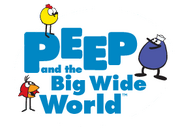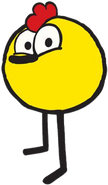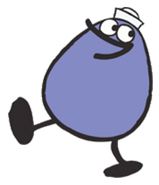
Peep and the Big Wide World's logo used since 2015; differs from the 2004 logo as Chirp's wings aren't perked up
Peep and the Big Wide World is a cartoon that was produced by WGBH and 9 Story Entertainment for TVOntario and Discovery Kids with the aim of teaching preschoolers basic science. The TV series has an website and the episodes are available online with the series being based off an older black and white film called The Peep Show and its remake. The series ran from April 12 of 2004 to October 14 of 2011 spanning five seasons with a total of 60 episodes equaling 120 episode segments. The theme song of the show is preformed by Taj Mahal. There is also a version that includes Pocoyo afterwards.[1]
Layout[]
Each episode consists of a pair of two 9-minute animated segments; at the end of each animated segment is a 2-minute live action portion in which children conduct a simple science experiment that reinforces the idea of the episode. Once the original episodes had aired on TLC (The Learning Channel), they were split in half (i.e. one 9-minute animated segment followed by a live action portion.) These shorter versions of Peep and the Big Wide World are shown on TVO in Canada, a co-developer of the series.
At the start of each episode, the theme song is played. The version that includes Pocoyo at the end has credits for all character voice actors in general (as opposed to only the specific character voice actors in that episode like the original). Every episode has a unique title card preceding it that contains a short animation of one character or more characters and some element related to the story, the episode's title placed at the top in colored text with one part placed over the other horizontally slanted, and usually the names of the individuals that wrote the episode and made the storyboard in black text beneath and placed in the same slanted fashion.
At the end, an instrumental version of the theme song plays at the credits. As the credits go by, some characters appear in each section. For the version that includes Pocoyo, the credits only go by. The instrumental version of the theme song is still heard, but the only thing that happens in the background is Peep, Chirp, and Quack bumping into each other, looking down, and then at the viewers.
Overview[]
Peep and the Big Wide World follows the adventures of a curious newborn chick named Peep and his best friends, Chirp the robin and Quack the duck. The three birds explore the world around them, collectively called the Big Wide World, and learn about basic scientific principles. Each episode is typically a self-contained story that has no connection to the previous or next episode; though, on occasions, two episodes will be part of one storyline or an episode will make a reference to a prior event.
Episodes are set in an outdoor area that typically shown containing open grassy plains, hills, and groups of tall trees though some areas are shown containing other landforms such as forests, large lakes, ravines, and sandy seashores. A diverse group of animals solely populate the setting of Peep and the Big Wide World and are sometimes shown living in certain set areas. On occasions man-made structures and humans have appeared with the most notable areas being those that show evidence of dumping, a playground, and the area around Nellie's doghouse.
Characters[]
Protagonists[]
- Peep - The eponymous character, Peep is a young male chicken that was born from an egg and resides in a bean can. Peep is shown as being curious about the world around him and somewhat naive and often appears along side the other protagonists.
- Quack - A male blue duck who resides in a pond and is portrayed as being selfish, bossy, and obsessed with ducks, though he has shown some caring for others.
- Chirp - A young female robin who live in a small tree who wishes to fly and mature.
Major characters[]
- Narrator - Appears in every episode and, as its name suggests, provides solely narration but has been seen interacting with characters.
- Newton - A turtle who live under a crabapple tree and takes things slowly in both movement and speech.
- Beaver Boy - A young, easy-going, buck-toothed beaver who tends to nickname other characters and lives in a beaver dam.
- Frog - Amphibian with superior jumping abilities that is often seen near bodies of water on top of lily pads and typically say only "ribbit" or "hop" when jumping. He rarely speaks. In the episode "Sounds Like..." Frog interacts with Peep and Chirp when they startle him while hopping.
- Squeak - A worrying mouse who lives under a brick and speaks in a high-pitched voice.
- Raccoon - Lives in the dump and offers junk to other characters.
- Skunk - Makes smells bad enough to wake up ducks and is largely apathetic.
- Fish Jr. - A small red fish who is curious about the world above her.
- Nellie - A dog who lives in a doghouse and is familiar with the patterns of the world.
- Tom - A trouble making, sneaky tomcat who acts as an antagonist in the series.
Minor characters[]
- Beaver Boy's parents - The mother and father of Beaver Boy who live with their son in their family dam.
- Mole - Usually offscreen in molehills but sometimes shown in other locations.
- Splendid Bird - A quetzal-like bird who escaped from a cage after being captured in the jungle and is introduced in Season 5.
- Hoot - An owl who appears to be older and lives in a large tree in the Deep Dark Woods.
- Snail - One of the pond dwellers of Quack's pond who is often seen with the fish.
- Robin - An older robin who teaches Chirp "bird lessons" and flies south at the end of Chirp Flies the Coop.
- Inchworm - Seen in a few episodes of the show and doesn't talk but can make noises.
- Dragonfly - A small dragonfly who cannot completely see in the dark.
- Blue Jays - A pair of bluejays who often mean well but usually cause trouble for the protagonists.
- Pink Quack - A pink version of Quack who appears in two episodes, changes his name to "Plurp", and calls him a "squink". She is a minor antagonist in the show.
- Salamander - An amphibian pond dweller that lives in Quack's Pond.
- Crab - A freshwater crab that lives in Quack's Pond.
- Crawfish - An animal that lives in Quack's Pond, and does not like getting scolded by Quack.
- Porcupine - Possesses quills that have come into contact with other characters.
One-time appearance[]
- Flies - Only appeared in Nosing Around. They are attracted to smelly scents, and have no speaking role.
- Willow - One of three turtles in a show, and like Newton, lives under a tree. Appears in Meeting Half-way.
- Chameleon - Seen at the end of Hide and Go Peep, playing hide-and-seek with the others.
- Quack Jr. - A baby turtle which hatched from an egg that Quack sat on for a short period of time in Quack Hatches An Egg.
- Pill Bug - A pill bug who lives in the ground as seen in The Root Problem and is not a berry.
- Caterpillar - Meets Peep in Peep's New Friend and turns into a "weird green thing", then a "weird brown thing" (cacoon), and finally a butterfly.
Species[]
- Worms - Animals with no lines that that crawl and come out after rain. Quack mistakenly calls them "lurmies".
- Rabbits - Reside in tunnels. Often seen hopping and greeting other characters. Bunnies look exactly the same as the rabbits, however they say "Hop" when they jump. There is an orange rabbit as well.
- Squirrels - Voiceless character who appear to be primarily concerned with nuts and communicate by miming. A running gag throughout Peep and the Big Wide World is that squirrels miming to speak will result in the further confusion of the protagonists.
- Ants - Reside in anthills and are often seen in groups near their homes or areas containing food. Some will occasionally speak but often in low, squeaky voices.
- Hummingbirds - Are always seen hovering in the air by their repeatedly flapping wings and are accompanied by a humming noise.
- Bats - Nocturnal animals that are seen flying in a group or alone at night and like mysteries.
- Bees - Often seen around flowers collecting pollen and speak in high-pitched voices.
- Fish - Reside in lakes and pond in various sizes and colours. The most prominent examples of fish are those that reside in Quack's pond.
- Robins - Appear on occasions and possibly live in trees and also speak in distinct female voices. The protagonist Chirp is a baby robin.
- Ducks - Species of protagonist Quack and minor character Pink Quack. Appear to believe that ducks are superior to all other animals. There are also multiple colored ducks in Bedtime Story, but that was only in Quack's story.
- Butterflies - Flying insects of varying sizes and colours that emerge from cocoons made by caterpillars. Butterflies go south.
- Crows - Birds that like shiny objects and make cawing noises that scare ducks out of their ponds.
- Chipmunks - Speak in chirrups and have been shown having a fondness for apples.
- People - Humans who are rarely seen in the series but have been seen riding vehicles and playing on rocks.
- Groundhogs - Seen in Bringing Spring and apparently determine the arrival of spring using shadows. Groundhogs live in caves like bats.
- Seagulls - Seen in Chirp's Flight Program and fly without flapping at Big Bay.
- Birds - They are the type of species Peep, Chirp, and Quack are. Other birds like a red bird, black bird, and chickadee only appeared in Chirp, Chirp, Tweet, Tweet, Chirp.
Game exclusively[]
- Robin (red) - Only appears in the game Round and Round.
Trivia[]
- Quack is the character that has cried the most. While Peep only cried three times, and Chirp cried two times, Quack cried 12 times.
- Ironically, when Peep and Chirp were born, they actually said their own names. Peep said "Peep" when he hatched out, and Chirp said "Chirp" when she hatched out. That is possibly how they got their names.
- Peep, Chirp, and Quack's color scheme is somewhat similar to the main characters in Cars 3. Peep is yellow like Cruz Ramirez, Chirp is red like Lightning McQueen, and Quack is blue like Jackson Storm, though this show was released years before that movie.
- The show has the following awards and nominations:
- 2012 Nominee Daytime Emmy. Outstanding Children's Animated Program.
- 2008 Nominee Daytime Emmy. Outstanding Children's Animated Program.
- 2008 Winner Daytime Emmy. Outstanding Writing in Animation.
- 2008 Nominee Gemini. Best Pre-School Program or Series
- 2007 Nominee Daytime Emmy. Outstanding Children's Animated Program.
- 2006 Nominee Daytime Emmy
- 2006 Winner Professional Non-Fiction Division: Children's Programs.
- 2005 Winner Daytime Emmy. Outstanding Children's Animated Program.
- 2005 Winner Gemini. Best Pre-School Program or Series
Games[]
This show has 15 games that can be selected. Click here for more information. Some games are accessible in the Peep and the Big Wide World website.[2]
Gallery[]
References[]
External links[]
- Peep and the Big Wide World Website
- Peep and the Big Wide World on IMDb
- Peep and the Big Wide World on Wikipedia
| |||||||||||



